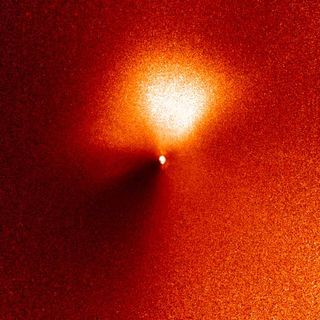Deep Impact Spacecraft Observes Massive Comet Outburst

NASA's DeepImpact spacecraft has observed a massive, short-lived outburst of ice or otherparticles from comet Tempel 1 just days before thecraft will release a probe to slaminto the comet.
The outburst,which occurred June 22 and was announced today, was larger than one photographedrecently by the Hubble Space Telescope.
The latesteruption temporarily expanded the size and reflectivity of the cloud of dustand gas, called a coma, that surrounds the cometnucleus.
"Thismost recent outburst was six times larger than the one observed on June 14, butthe ejected material dissipated almost entirely within about a half day,"said University of Maryland astronomer Michael A'Hearn, who leads the DeepImpact mission.
An animationof the June 22 eruption is available here.
Early results
The DeepImpact mission is designed to carve a crater in the comet, releasing primordialmaterial for study in an effort to learn specifically what comets are made of.
Get the Space.com Newsletter
Breaking space news, the latest updates on rocket launches, skywatching events and more!
Thespacecraft's instruments found that during the June 22 outburst, the amount ofwater vapor in the coma doubled, while the amount of other gases, includingcarbon dioxide, increased even more.
"Outburstssuch as this may be a very common phenomenon on many comets, but they arerarely observed in sufficient detail to understand them because it is normallyso difficult to obtain enough time on telescopes to discover suchphenomena," A'Hearn said. "We likely would have missed this excitingevent, except that we are now getting almost continuous coverage of the cometwith the spacecraft's imaging and spectroscopy instruments."
Two eruptionsin as many weeks suggests the activity is common.
Deep Impactco-investigator Jessica Sunshine, with Science Applications InternationalCorporation (SAIC), agreed that observing such activity twice in one weeksuggests outbursts are fairly common.
"We mustnow consider them as a significant part of the processing that occurs on comets as they heat up when approaching theSun," said Deep Impact co-investigator Jessica Sunshine, with ScienceApplications International Corporation.
Looking good
The latestevent was observed with the spacecraft's spectrometer, which splits light intoits constituent parts for chemical analysis.
"Thespectrometer is working very well and we already are able to see changes in themakeup of the fresh material extruded from the comet," Sunshine said."We are still a long way from the comet, so this bodes very well for ourability to observe and characterize changes in the comet's materials, before,during, and after our impact."
Eruptions likethis are believed to be associated with the heating of comet material by theSun. Comet Tempel 1 is near perihelion, or the pointin its orbit at which it is closest to the Sun.
"For theJune 22 event, it is the rapid dispersal of this outburst that raises the mostquestions," said A'Hearn. "It looks as though the puff was nearlyinstantaneous and that simple radial expansion is not enough to make thebrightness go down as fast as it did. Thus the particles must also either be vaporizing,and thus disappearing, or getting much darker after release, and 'disappearing'in that way."
"Thisadds to the level of excitement as we come down to the final days beforeencounter," said Rick Grammier, Deep Impactproject manager at NASA's Jet Propulsion Lab in Pasadena, Calif. "But thiscomet outburst will require no modification to missionplan and in no way affects spacecraft safety."
- Deep Impact: Viewer's Guide & News Updates
Join our Space Forums to keep talking space on the latest missions, night sky and more! And if you have a news tip, correction or comment, let us know at: community@space.com.

Space.com is the premier source of space exploration, innovation and astronomy news, chronicling (and celebrating) humanity's ongoing expansion across the final frontier. Originally founded in 1999, Space.com is, and always has been, the passion of writers and editors who are space fans and also trained journalists. Our current news team consists of Editor-in-Chief Tariq Malik; Editor Hanneke Weitering, Senior Space Writer Mike Wall; Senior Writer Meghan Bartels; Senior Writer Chelsea Gohd, Senior Writer Tereza Pultarova and Staff Writer Alexander Cox, focusing on e-commerce. Senior Producer Steve Spaleta oversees our space videos, with Diana Whitcroft as our Social Media Editor.
